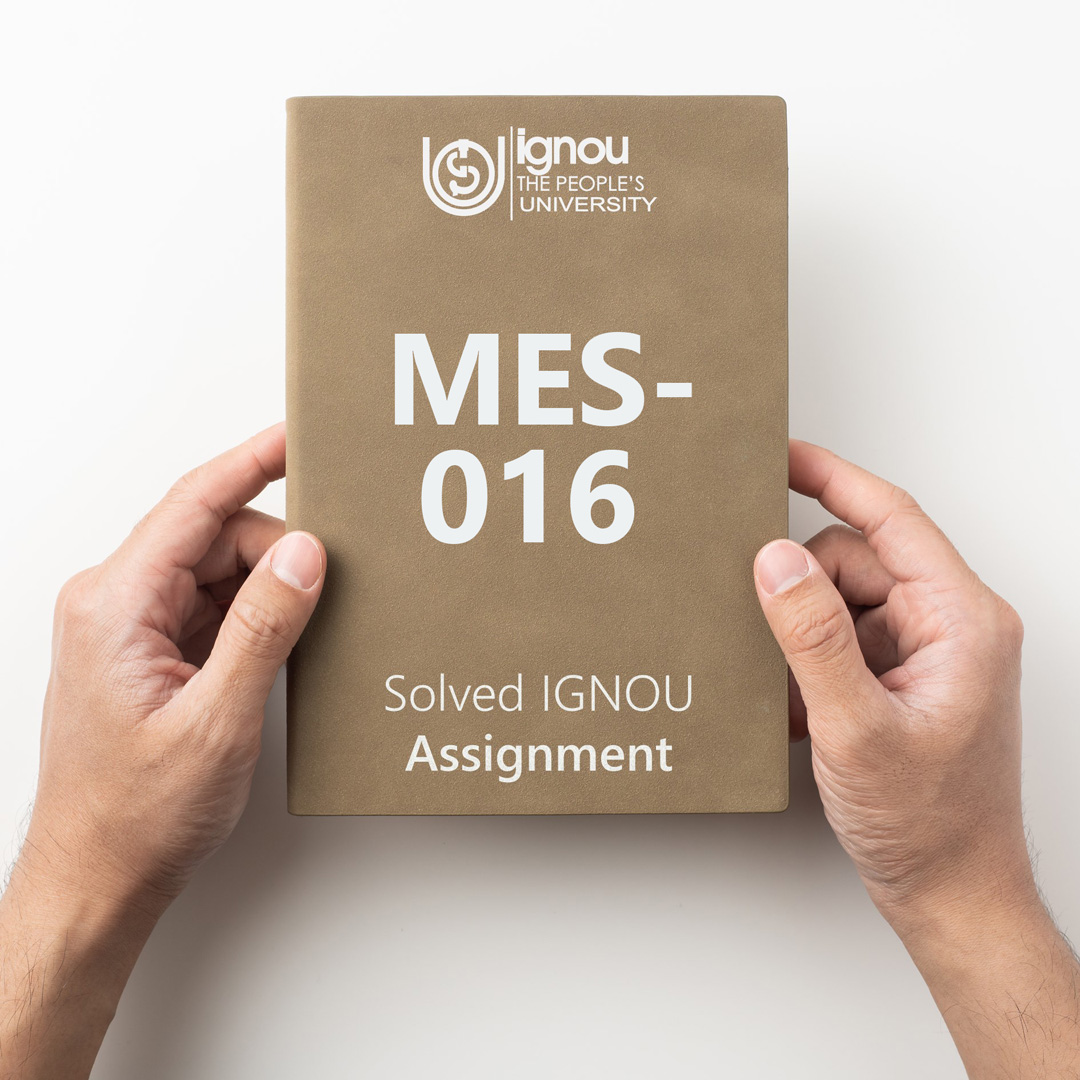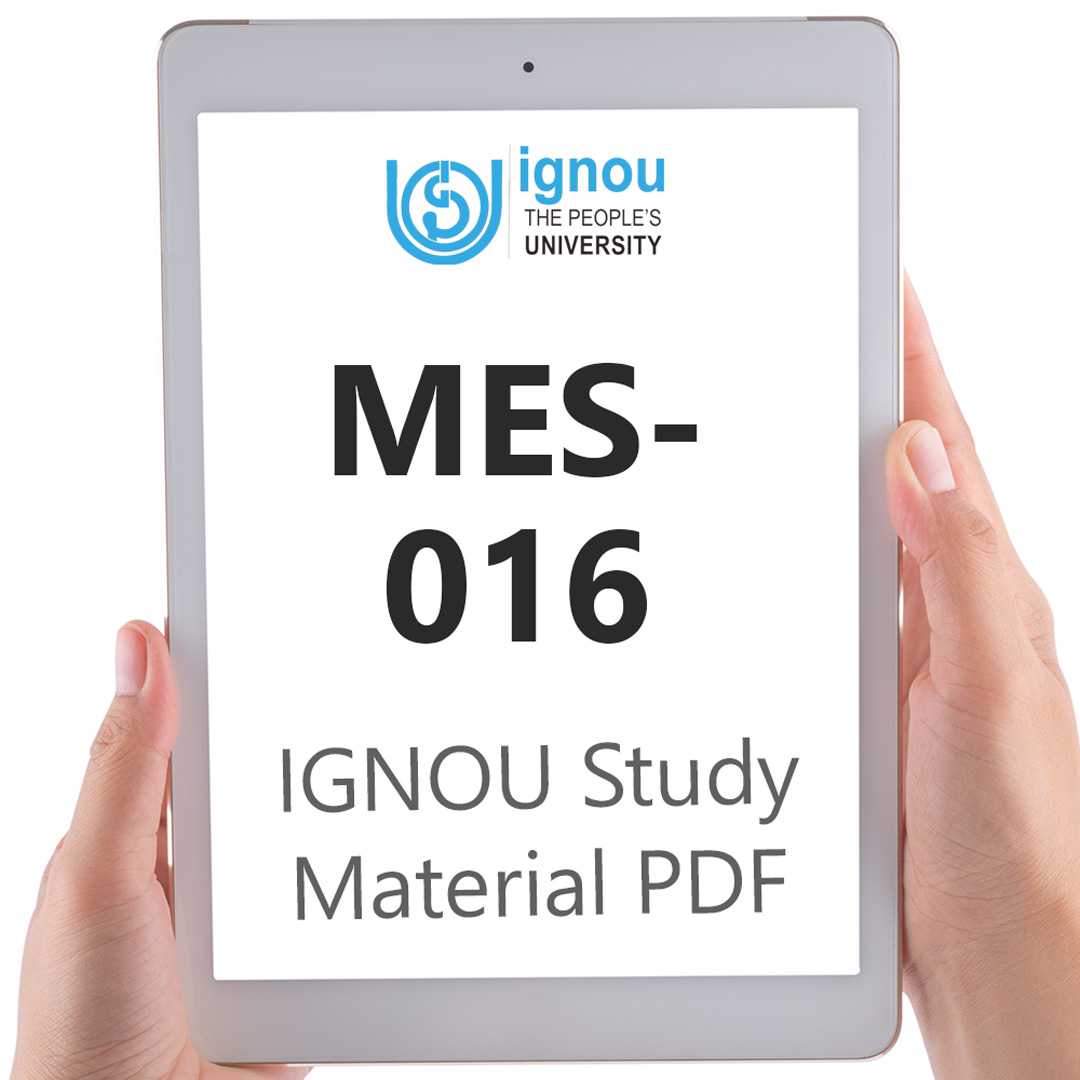If you are looking for MES-016 IGNOU Solved Assignment solution for the subject Educational Research, you have come to the right place. MES-016 solution on this page applies to 2023 session students studying in MAEDU, MAAE, PGDAE courses of IGNOU.
MES-016 Solved Assignment Solution by Gyaniversity
Assignment Code :MES-016/TMA/2023
Course Code: MES-016
Assignment Name: Educational Research
Year: 2023
Verification Status: Verified by Professor
a) Explain the meaning and characteristics of qualitative research. Discuss how qualitative research is different from quantitative research. (500 words)
Ans) Qualitative research looks at complex human and social problems as a whole. This is different from the scientific method, which looks at isolated variables, situations, or events. In qualitative research, the focus is on the researcher, who tells stories and makes sense of things based on how they relate to people's experiences, events, etc. Qualitative research uses many different ways to collect qualitative data, such as case studies, interviews, dialogues, observations, personal experience, life stories, visual data like photography, etc.
Characteristics of Qualitative Research
Multiple Realities: Qualitative research presupposes multiple social and educational realities. Concrete realities exist. People view them differently, thus they have distinct mental constructions. In other words, realities are perceived at a given time. Reality changes with social and educational conditions. Context-specific realities cannot be generalised.
Meanings and Interpretations: Qualitative research focuses on interpreting educational objects, events, and processes. They cannot associate social and behavioural changes with physical motions that may be observed externally. Instead, understanding human behaviour or a social phenomenon requires understanding men and what they do.
Generation of Knowledge: Qualitative inquiry requires knowledge from respondent-inquirer interaction. Respondents answer questions about their activities and perceptions. To maximise responsiveness and understanding into the problem, the inquirer and respondents communicate.
Generalization: Researchers reject scientists' generalisation method. They contend that genderised knowledge is not true knowledge since generalisations destroy significant information in individual units. For them, knowledge generation must account for real evidence in varied settings.
Human Relations: Many intrinsic variables, events, and processes influence human relations. Thus, naturalistic research cannot establish one-to-one cause-effect correlations. Social sciences cannot prove causality like physical sciences. Social and behavioural studies only suggest plausible influences.
Value Systems: Qualitative researchers reject value-free inquiry. Value systems affect problem identification, sample selection, tool use, data collection, data conditions, and inquirer-respondent interaction.
Key Differences between Qualitative Research and Quantitative Research
Research Approach: Qualitative research examines the social world through the eyes of people. Quantitative research measures and analyses data using statistical approaches.
Research Design: Qualitative research uses an exploratory study design to investigate complex social issues through participant perceptions and experiences. Quantitative research uses a deductive design to test hypotheses or ideas using numerical data.
Data Collection: Qualitative research uses open-ended interviews, observations, focus groups, and other non-standardized methodologies to better understand the study subject. Quantitative research collects huge volumes of data for statistical analysis using organised surveys, trials, and other approaches.
Data Analysis: Qualitative researchers use thematic analysis to find patterns and themes in data and comprehend the topic being studied. Quantitative research uses statistical approaches like regression analysis or hypothesis testing to determine variable relationships.
Research Findings: Qualitative research often yields rich and thorough descriptions of the social issue being examined. Quantitative research yields statistical evidence to support or disprove a hypothesis or idea.
b) Explain the meaning and importance of review of related literature. Describe how you will carry out review of related literature for a research study in education. (500 words)
Ans) A review of related literature is a critical analysis and synthesis of existing literature, research studies, and publications on a specific topic. It involves a comprehensive review of the current state of knowledge in the field, which includes both theoretical and empirical literature.
Importance of a Review of Related Literature
Identify Knowledge Gaps: A review of related literature helps to identify areas where further research is needed. It can also help to identify knowledge gaps in the existing literature, which can be addressed by future research.
Develop a Research Question or Hypothesis: A review of related literature can help to refine and develop a research question or hypothesis. It can also provide a framework for conducting research, and can help to establish the significance of a research problem.
Avoid Duplication of Research: A review of related literature can help researchers to avoid duplicating previous research efforts. By identifying what has already been studied and what has not, researchers can focus their efforts on new and innovative research questions.
Establish the Context: A review of related literature can provide the context for a research study. It can help to explain the significance of the research problem and the rationale for the research question or hypothesis.
Evaluate the Quality of Existing Research: A review of related literature can help researchers to evaluate the quality of existing research. It can help to identify strengths and weaknesses of previous studies, and to determine the credibility and validity of research findings.
Some Steps to Carry Out Review of Related Literature for a Research Study in Education
Step I: Define the scope and focus of the literature review: The first step is to define the scope and focus of the review. This involves identifying the key concepts, theories, and research questions that will guide the review.
Step II: Conduct a comprehensive search: Conduct a systematic search of relevant databases, journals, books, and other sources to identify relevant studies and literature. Keywords and phrases should be used to guide the search.
Step III: Evaluate the quality and relevance of the literature: Evaluate the quality and relevance of the literature by reviewing the title, abstract, and keywords of each article. The literature should be critically evaluated for its methodology, relevance, and contribution to the field.
Step IV: Organize the literature: Organize the literature by grouping studies based on their relevance and methodology. Identify the key themes and controversies that emerge from the literature.
Step V: Synthesize the literature: Synthesize the literature by analysing the findings, identifying common themes and trends, and summarizing the key findings.
Step VI: Identify gaps and research questions: Identify the gaps in the literature and formulate research questions that address these gaps. These research questions should be aligned with the research objectives and methodology of the study.
Step VII: Write the literature review: Write the literature review by summarizing the key findings, identifying the gaps and controversies, and formulating the research questions. The literature review should be organized and presented in a logical and coherent manner.
In summary, a well-conducted review of related literature is an essential component of any research study in education. It helps the researcher to identify the gaps and controversies in the literature, formulate research questions, and design an appropriate research methodology. The steps described above can be used to guide the process of conducting a review of related literature for a research study in education.
c) Identify a problem you have experienced in school or higher education system in India. Prepare a detailed proposal for conducting research study on the same problem. (500 words)
Ans) Title of the Problem: Assessing the Impact of Traditional Examination System on Student Learning and Achievement in Indian Higher Education
Introduction: The education system in India is known for its high academic rigor and focus on rote learning. One of the key components of this system is the traditional examination system, which plays a vital role in evaluating student performance and determining academic progress. However, the effectiveness of this examination system in promoting student learning and achievement is a matter of debate. The current study aims to explore the impact of the traditional examination system on student learning and achievement in Indian higher education.
Statement of the Problem: The traditional examination system has been the backbone of Indian higher education for decades, but its impact on student learning and achievement remains unclear. Critics argue that the emphasis on memorization and recall may not promote deep understanding or encourage critical thinking, while supporters claim that this system is essential for maintaining academic standards and promoting student success. Given the lack of consensus on this issue, it is important to conduct a thorough investigation of the impact of the traditional examination system on student learning and achievement.
Review of Related Literature: Several studies have been conducted on the traditional examination system in India, highlighting its strengths and weaknesses. Research suggests that the emphasis on memorization and recall can lead to surface-level learning, as students focus on rote memorization rather than understanding concepts deeply. Furthermore, the traditional examination system may not accurately reflect student learning or measure the development of critical thinking and problem-solving skills. However, some studies argue that this system provides a fair and objective measure of academic performance and helps maintain high standards of academic rigor.
Objectives:
Investigate the impact of traditional examination systems on student learning and achievement in Indian higher education. Identify the strengths and weaknesses of the traditional examination system in promoting student learning and achievement.
Explore the perceptions of educators and students regarding the effectiveness of the traditional examination system.
Identify strategies that can be used to enhance the effectiveness of the traditional examination system in promoting student learning and achievement.
Research Questions:
What is the impact of the traditional examination system on student learning and achievement in Indian higher education?
What are the strengths and weaknesses of the traditional examination system in promoting student learning and achievement?
What are the perceptions of educators and students regarding the effectiveness of the traditional examination system?
What strategies can be used to enhance the effectiveness of the traditional examination system in promoting student learning and achievement?
Definition of Terms:
Traditional Examination System: The system of testing students' knowledge and understanding through written examinations that emphasize memorization and recall.
Student Learning: The process of acquiring new knowledge and skills through study, instruction, and experience.
Student Achievement: The extent to which a student has accomplished the learning outcomes specified by the course or curriculum.
Methodology: The research will use a mixed-methods approach, including surveys, interviews, and focus groups. A sample of 500 students and 50 educators will be selected from different higher education institutions across India. The study will use both quantitative and qualitative data analysis methods to examine the impact of the traditional examination system on student learning and achievement.
Time Schedule:
Phase I: Preparation and Data Collection (4 months)
Literature Review and Data Collection
Development of Research Instrument
Pilot Study
Data Collection
Phase II: Data Analysis (5 months)
Data Cleaning and Entry
Descriptive Analysis
Inferential Analysis
Qualitative Analysis
Phase III: Report Writing and Dissemination (3 months)
Report Writing
Presentation of Findings
Publication
Budget/Financial Estimates: The estimated budget for the study is INR 25,00,000.






